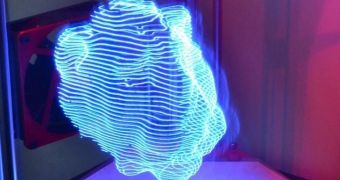Light is intangible, so you can't really use it to make anything tangible. That doesn't mean you should shelve your imagination though. One man, at least, didn't think so when he set about turning his latest project into something real.
Although “real” might not have the same meaning here as it does everywhere else. After all, the things he caught on photo and in the video below aren't actually, well, real. More like hypothetical light sculptures.
They look pretty cool though, blue and glowing. Such is the result when you replace the plastic filament in an FDM 3D printer with a LED.
Well, that's not exactly what happened. It's not like he replaced the spool of plastic wire with a wire LED, if such a thing even exists. Instead, the LED was attached to the print head.
And as he pressed “print” and let the machine go about its business, the man, by the name Ekaggrat Singh Kalsi, filmed everything on camera, so that he would, at the end of it, be able to visualize a 3D printed object made wholly out of light.
To get the desired outcome, the man used a Nikon D3100 camera in BULB mode and took a photograph using a very long exposure value. He essentially captured the path that the LED light traveled according to the code he inputted.
Needless to say, the extruder in the printer was disabled, because he wasn't aiming to actually print anything. Ekaggrat calls his idea the latest twist to the technique known as “light painting.”
We'll let you decide for yourselves if the photos created at the end of it all are really as astonishing as Ekaggrat seems to think. We will say this though: that the sinuous light lines give everything a cool, futuristic, holographic allure.
It took two days for everything to be done, and the next order of business will be to add RGB color and do some more light painting.
While he does that, we'll be here wondering how long it will take for some sort of LED-embossed filament to be created. In theory, if you mix LEDs with a conductive substance and make a filament out of it, you could make objects that glow from every part of their, well, bodies.
The only dilemma is how to make the LEDs survive intact through the whole superheating process, if that's even possible. Particularly when taking into account that making LEDs small enough won't be the easiest task either.

 14 DAY TRIAL //
14 DAY TRIAL //